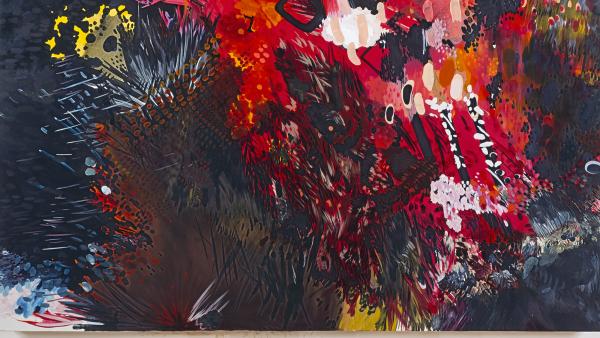What do we mean when we talk about Contemporary Art?
A hundred years ago, the artist Marcel Duchamp gave up painting in favour of presenting existing objects as works of art, explaining, “I was interested in ideas - not merely in visual products.”[1] He argued that an everyday object could become a work of art if the artist said it was. This prompted a new movement called conceptual art, which took idea rather than appearance as the most important aspect of an artwork.
Contemporary art is the art of now, but the term has come to mean more than simply when an artwork was made. Contemporary art also describes an approach that is different to the ways artists have worked in the past; using a visual language, references and materials that are all around us. The meaning of a contemporary artwork is not necessarily rooted in the history of art. Its meaning can come from anywhere.
Due to the advent of conceptual art, contemporary artists are no longer tied to painting, sculpture and printmaking. Now, art can be made of anything. The artwork can be a gesture or a performance, a sound or an installation made for a specific space.
Scotland + Contemporary Art
Painting
For centuries, painting was the reigning medium for artists. Since the invention of photography in 1839, however, the importance of painting has been questioned. In the 1960s artists and critics talked about the ‘dematerialisation of art’, where ideas became more important than objects, and the slow, traditional route of painting seemed a lot less exciting. However, artists have never stopped making paintings, even if they were less popular for a time.

Since the early 1990s, artist Louise Hopkins (b. 1965) has used fabrics, maps, song sheets, comics and pages of magazines to create works that address the process and problems of representation (of people, objects and cultures) in art. The materials Hopkins chooses to paint on often have social or political associations. In her work Untitled (169) 2006, she has applied ink over a world map, developing strokes in different directions and leaving the names of oceans and countries intact. By using painting in this way, the artist is altering a surface, transforming its meaning in order to question ideas about representation through her processes of mark-making.
Installation Art
Installation art is a catch-all term that describes an arrangement of objects in an exhibition space; a room full of sculptures or a space filled with video monitors, for example. What marks an installation as distinct from sculpture or other traditional art forms is its emphasis on a total, unified experience, rather than a display of separate, individual artworks.
The term first came into use in the 1960s to describe the way in which an exhibition was set out in a gallery. It was particularly popular with Minimalist[2] artists whose work was often installed so that the interconnections between the objects and their surroundings were highlighted. In this way, it was hoped that viewers could take in both the artwork and its environment as an overall display. From the 1960s onwards the term Minimalism was used to describe an art movement, mainly of American sculptors such as Donald Judd and Robert Morris, who worked with simple, often repeated, forms and industrial materials.
Performance Art
Performance art describes ‘live’ works in which the body of the artist or other performer is the medium. It can be traced back as far as the early 1900s with the emergence of avant-garde art movements such as Dadaism[3], but it wasn’t popular as an art form until the 1960s. In the 1970s Joseph Beuys (1921-1986) was making ‘action-performances’ which involved dead hares and live coyotes, and in 1975 Carolee Schneemann (b. 1939) famously unravelled a scroll from her vagina in a performance called Interior Scroll. Schneemann (along with many other female-identified artists) has used her own body to explore issues of oppression in relation to sexuality and gender.
The rise of performance art in the twentieth century meant that artists became heavily reliant on documentation as a record of their work. Scottish artist Pete Horobin systematically recorded his daily actions from 01.01.1980 - 31.12.1989 using templates to log his daily consumption, feelings, health, sleeping, socialising and thinking. This became the Daily Action Time Archive (DATA). He has changed his name several times as a means of demarcating each ten year project he has undertaken; making a clear break between one ‘persona’ and the next.


Film and Video
Film and video first became popular with artists in the 1960s, and many artists have since experimented with this relatively new medium. Andy Warhol (1928-1987) was one of the first to explore moving image, making both short, experimental, and full-length feature films. Though not always clearly delineated, one potential difference between films made for mainstream cinema, and artists’ film and video, can be their duration: the former tend to follow a predictable length of around two hours, whereas with the latter this varies wildly from a matter of seconds to days.
In 1993, Scottish artist Douglas Gordon created 24 Hour Psycho, in which he slowed down the famous Alfred Hitchcock film, Psycho (1960), to last a full 24 hours, making it impossible to view it in its entirety (and to follow the storyline in the way that Hitchcock intended) due to gallery opening hours. Artists working with moving image often play with the traditional format of a story told through film, such as Scottish artist Rachel Mclean (b. 1987), who says of her latest film: It is quite a fragmented narrative, and I am working with a continuous loop, there is no distinct beginning and end.[4]


